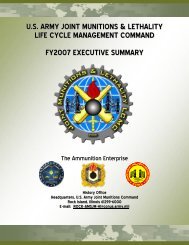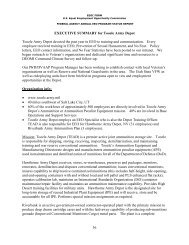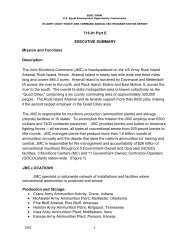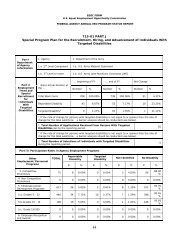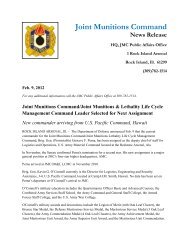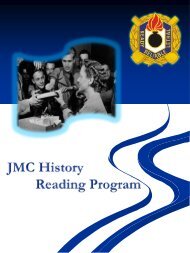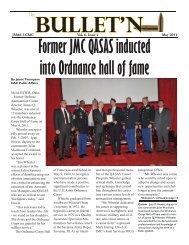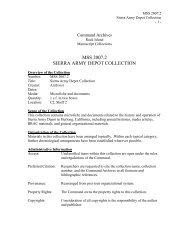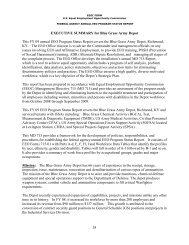History of the Ammunition Industrial Base - JMC - U.S. Army
History of the Ammunition Industrial Base - JMC - U.S. Army
History of the Ammunition Industrial Base - JMC - U.S. Army
Create successful ePaper yourself
Turn your PDF publications into a flip-book with our unique Google optimized e-Paper software.
<strong>Base</strong> Assessment Tool (IBAT). The SMCA <strong>Industrial</strong> <strong>Base</strong> Assessment Team (IBAT) is an<br />
initiative to automate <strong>the</strong> <strong>Ammunition</strong> Production <strong>Base</strong> Plan to facilitate industrial base<br />
preparedness planning in acquisitions. The SMCA IBAT is a web-based data system that<br />
documents <strong>the</strong> production capabilities, capacities, production schedules, deficiencies, and<br />
industrial base metrics <strong>of</strong> <strong>the</strong> SMCA ammunition supply chain to assist in optimizing acquisition<br />
decision making that affects <strong>the</strong> preparedness <strong>of</strong> <strong>the</strong> National Technical <strong>Industrial</strong> <strong>Base</strong> (NTIB).<br />
The data system also provides “what-if” scenario generation and ammunition maps to identify<br />
potential supply chain choke points. The data system contains over 500 end items and over 700<br />
components and will be a viable asset to assessing <strong>the</strong> industrial base.<br />
The IBAT is used to help <strong>the</strong> command perform industrial preparedness planning for<br />
critical ammunition end items. The IBAT assists <strong>the</strong> ammunition enterprise in planning<br />
production schedules for peacetime and emergency surge demands. Instead <strong>of</strong> focusing on<br />
replenishment, leaders will be able to focus on capabilities-based planning and support current<br />
operations. The IBAT contains real time data on capacities, workforce skills, technologies,<br />
stockpile levels, deliveries versus schedules, customer satisfaction, environmental data, financial<br />
viability <strong>of</strong> producers, POM item costs, and more. It also contains analytical tools that predict<br />
base responsiveness against any set <strong>of</strong> requirements. While still in developmental phases <strong>the</strong><br />
tool has already proved to be useful in providing real time data. The IBAT has gone from a once<br />
every two year assessment to providing real time data to <strong>the</strong> entire ammunition community. It<br />
also contains simulation tools to calculate pacing operations and has <strong>the</strong> ability to respond to<br />
various conflict scenarios. 175<br />
Armament Retooling and Manufacturing Support (ARMS)<br />
One issue that continuously hampers <strong>the</strong> sustainment <strong>of</strong> industrial installations is <strong>the</strong><br />
inability to maintain a pr<strong>of</strong>it during peacetime. Historically, facilities were emptied and<br />
completely inactivated and <strong>the</strong>refore not maintained. The Armament Retooling and<br />
Manufacturing Support (ARMS) Program lowered <strong>the</strong> cost <strong>of</strong> ownership <strong>of</strong> <strong>Army</strong> government<br />
owned-contractor operated (GOCO) ammunition plants while creating jobs and retaining critical<br />
skills and machinery in <strong>the</strong> industrial base. The ARMS program provides opportunity to use<br />
underutilized portions <strong>of</strong> ammunition plants. The ARMS Program is designed to encourage<br />
commercial use <strong>of</strong> <strong>the</strong> <strong>Army</strong>`s inactive ammunition plants through many incentives for<br />
businesses willing to locate to a government ammunition production facility. The ARMS<br />
Program was established by an Act <strong>of</strong> Congress in FY93 as P.L. 102-484, dated 23 October<br />
1992, now codified as 10 USC 4551-4555, dated 30 October 2000. In FY01, Congress extended<br />
<strong>the</strong> concept to <strong>the</strong> manufacturing arsenals by creating <strong>the</strong> Arsenal Program Support Initiative<br />
(ASPI). ARMS meets <strong>the</strong> intent <strong>of</strong> Congress with verified lower cost <strong>of</strong> production, retention <strong>of</strong><br />
critical technical skills, significant contractor-funded modernization, and <strong>the</strong> reduction or<br />
elimination <strong>of</strong> <strong>the</strong> annual cost <strong>of</strong> facilities maintenance. The program is successful and<br />
maintenance costs <strong>of</strong> three ARMS facilities have been reduced to zero due to <strong>the</strong> benefits<br />
obtained by tenant use.<br />
In October 2003, <strong>the</strong> ARMS Program won <strong>the</strong> 2003 CoreNet Global Innovators Award<br />
recognizing new entrants in <strong>the</strong> corporate real estate industry that develop and apply innovative<br />
175 Al Beuster, “The Single Manager for Conventional <strong>Ammunition</strong> <strong>Industrial</strong> base Assessment Tool,” <strong>Army</strong> AL&T<br />
(July-August 2004), 64; PEO <strong>Ammunition</strong>. <strong>Ammunition</strong> <strong>Industrial</strong> <strong>Base</strong> Management Briefing.<br />
59



